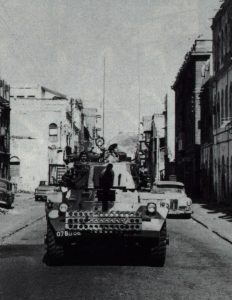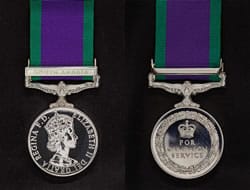Aden
Aden, situated on the south coast of what is now Yemen, had been a British colony since 1839. Commanding the southern entrance to the Red Sea, it was an important British air and naval base on the route to India. It was also crucial for safeguarding access to Middle Eastern oil supplies.

Aden, 1967
In January 1963, in response to growing nationalist unrest in the region, the British persuaded the sheikhdoms of the Aden Protectorates to merge with the Colony of Aden and from the Federation of South Arabia (FSA). These surrounding territories had always been semi-independent. But the British were able to influence their external relations and establish local garrisons in return for military protection.
In 1964, continuing to reduce its imperial commitments, the British Government announced that independence would be granted to the newly formed FSA by 1968. However, some British forces would stay on in Aden.
Inspired by President Nasser of Egypt, Arab nationalists formed the National Liberation Front (NLF) in Yemen, which itself had designs on Aden and its surrounding territories.
Their insurgency against British rule began with a grenade attack on the British High Commissioner on 10 December 1963, killing one person and injuring 50.
Trouble then developed in the mountainous Radfan region, where dissident local tribesmen raided the road connecting Aden with the town of Dhala near the Yemen border. In January 1964, three Federation Regular Army (FRA) battalions, with British air support, restored order. But when they withdrew, trouble flared up again, with the rebels receiving NLF support.
On 29 April the authorities mounted a second expedition, this time with British Army soldiers. Together with two FRA battalions, they advanced rapidly through difficult terrain, capturing the ridges and hills that dominated the tribal areas. By 26 May 1964, they had taken the main rebel stronghold in the Wadi Dhubsan and suppressed the tribal revolt.
From November 1964, the NLF switched its efforts to Aden itself, where it began an urban terrorist campaign. British troops and their families, members of the local security forces and supporters of the government were all attacked.
In 1966 the British Government announced that all British forces would be withdrawn immediately on independence. Few locals in Aden believed that the existing FSA government would survive without British support and were therefore wary of being seen to support it.
As the NLF escalated their attacks, a second nationalist group, the Front for the Liberation of Occupied South Yemen (FLOSY), also began terrorist activities against the security forces.
In January 1967, there were riots by the supporters of both groups in the old Arab quarter of Aden. These continued until mid-February, despite the intervention of British troops.
Morale amongst the local security forces was now at an all-time low. On 20 June 1967, a mutiny in the Federation Army spread to the local police. Eight soldiers of the Royal Corps of Transport were killed when mutineers fired on their lorry.
Order was quickly restored, but rumours that the British were shooting mutineers led to a number of ambushes in the Crater area of Aden.
The Queen’s Own Hussars were deployed in the Crater area, patrolling for one hour on, one hour off for up to 15 hours a day in fairly dreadful conditions, keeping NFL away from FLOSY and FLOSY away from the NLF, and both away for themselves and the local population for some five months.
Later, the area of operation extended to Maalla and the waterfront in support of 45 Commando, Royal Marines.
During their time in Aden, the Queen’s Own Hussars were awarded an MC and 6 mentions in dispatches.
As the November 1967 date for the British withdrawal approached, the NLF and FLOSY began fighting each other for control of Aden, with the NLF gaining the upper hand.
In the last week of November, the remaining 3,500 men of the British garrison were evacuated.
The Queen’s Own Hussars stayed there until November 1967 when they were withdrawn, some by air, some on HMS Intrepid to Dubai, and some via the Cape on RFA Sir Galahad.
‘B’ Squadron stayed in Sharjah until March 1968, then went to Cyprus with the United Nations.
When the British left Aden in November 1967, the area rapidly fell under the control of the Marxist-oriented Front for the Liberation of South Yemen, which founded the People’s Democratic Republic of Yemen (PDRY).
Gallantry Awards
Campaign Medal
 The General Service Medal (GSM) 1962-2007 is awarded to army, RAF, Royal Navy and Royal Marines personnel who meet the qualifying criteria for service in any of the following geographical areas:
The General Service Medal (GSM) 1962-2007 is awarded to army, RAF, Royal Navy and Royal Marines personnel who meet the qualifying criteria for service in any of the following geographical areas:
Borneo, Cyprus, Radfan, South Arabia, Malay Peninsula, Northern Ireland, Dhofar, Lebanon, Gulf, Kuwait and North Iraq/South Turkey.
Medal Clasps:
- Borneo
- Cyprus 1963-64
- Radfan
- South Arabia
- Malay Peninsula
- Northern Ireland
- Dhofar
- Lebanon
- Gulf
- Kuwait
- North Iraq and South Turkey

